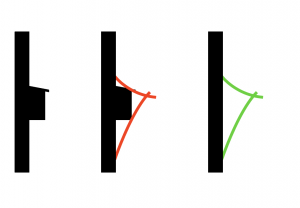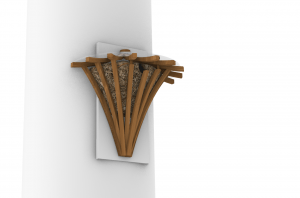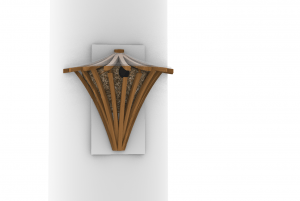Howdy reader, welcome aboard my 4th woodworking blog post.
In the previous blog posts, I have rambled about the design processes involved in a woodworking project. We covered everything from identifying a Parti to defining specific functional and aesthetic features. This led to us starting to identify potential partis, immediately gazing our sights towards nature, the most epic designer out there. While on a hike, I noticed the distinct form of a tree fungi, a shape that seemed perfect for cradling a bird nest. With this foundational parti, I was able to head back to drafting.

Fungi Used for Parti

Refining Process Combining Traditional Design With New Parti
A traditional birdhouse, composed of a few slabs of wood and nailed together, making the perfect family activity for many because of its simplicity. It’s easy to follow a pre-designed blueprint, however, very few lift the curtain and look into the history and complexity in this design. Today, you can see birdhouses in different colours, locations, and even materials, however, the birdhouses’ form varies very little. The same skeletal form of a rectangular prism and a hole cut into it can be visualized across many outrageously different designs. Now, like many other lasting designs in the world, the reason for why it has lasted so long is its simple and it works. The best things are most often the simplest, and proved worthy by working again, and again, and again. Of course, there are ways to make the birdhouse objectively better, heck, we may even add air conditioning for the bird’s sake, a buffet, and a personal swimming pool. However, because the traditional skeletal form has worked so well before so consistently, it would be wise to consider this in my design. As you can see in the following image, I am essentially smashing together my new and wild Parti (the Fungus) and carving it and adjusting its form so it encapsulates the functions of the traditional birdhouse as well.
Taking the traditional design and merging it with my new vision is in a way adjusting my wild design to meet the requirements of the bird. Because the traditional birdhouse meets all the requirements for the bird, that means I can mold my design to fulfill the requirements too by emulating aspects of the traditional design. The logic behind this technique is in no way professional, but it makes common sense.
Now, we have adjusted our parti to meet the requirements of the bird. The design looks promising, however, as my mentor suggested I should start viewing the design in 3D. This was a great suggestion since all this time I have been making a 3D object in 2D, only viewing in blueprints and drafts. This is when I used my skill from last year’s In-Depth: Rhinoceros 6 3D, to create a 3D model of my design. I’ve got to say, seeing my design come to life and interacting with it in 3D gave me a lot more insight, and I saw multiple potential flaws of this design invisible in 2D. One of which involved an angle that did not accommodate enough space to fit enough space inside. Using the 3D program in combination with another drafting software (AutoCAD), more adjustments were made to make the design more accommodating. At the end, the model was rendered for my mentor to preview.



This design was proposed to my mentor for review, and he made another wise suggestion to start prototyping. I am excited to arrive at my mentor’s garage where we will be working hands on to see this design in person and come to life. Through touching, fiddling, and looking at a physical prototype, we can hope to discover more flaws that were invisible on the computer screen. As you can see, the design process currently is a lot like a creative refining process.
- What has been your most difficult mentoring challenge so far? Why?
So far, the biggest challenge I have faced with the mentoring is getting enough communication between my mentor and I. Due to schedules for both of us, we commonly try to meet on weekends, however, when we are not meeting, we try to do a online chat style of communication. I would be able to send progress of the milestones in my design process, and he would be able to provide suggestions and feedback on the designs and processes. However, this poses a few problems as he may not see the message and reply with a time delay. I think this is understandable since we have not scheduled a dedicated time, so it can only rely on when he sees the message. Furthermore, with this check in technique, I am not able to work together with mentor throughout some of the questions I may have and rely more on autonomous learning.
- What is working well? Why?
The biggest accomplishment or thing that is working well is finally reaching the prototyping phase. The design process has been challenging, however, through the support of my mentor and time dedicated towards this project, we can finally move on to working with materials. I think we are able to reach this phase because of how seriously we took the design process of this project. Without carefully planning out the birdhouse design, we may have wasted materials by making small mistakes in the design and possibly having to start over with fresh materials. With the design refined upon, we can confidently move towards prototyping with materials and eventually creating the actual product.
- What could be working better? How can you make sure this happens?
For the future, I would like to improve the amount of communication between me and my mentor and involve him throughout more of the work process. Although I completely understand his busy schedule, I could potentially bring some of the design process into the discussion as we meet. This also brings me to the point that we will be starting to meet in person, where we will be able to have a lot more opportunities to work together step by step. This way, small mistakes are also accommodated for as he is supervising me. The last implementation I would like to improve the communication between me, and my mentor is the amount of progress reports I send when I am working individually. This will hopefully give him a better grasp of what I am doing at a granular level and seek potential flaws or suggestions more effectively.